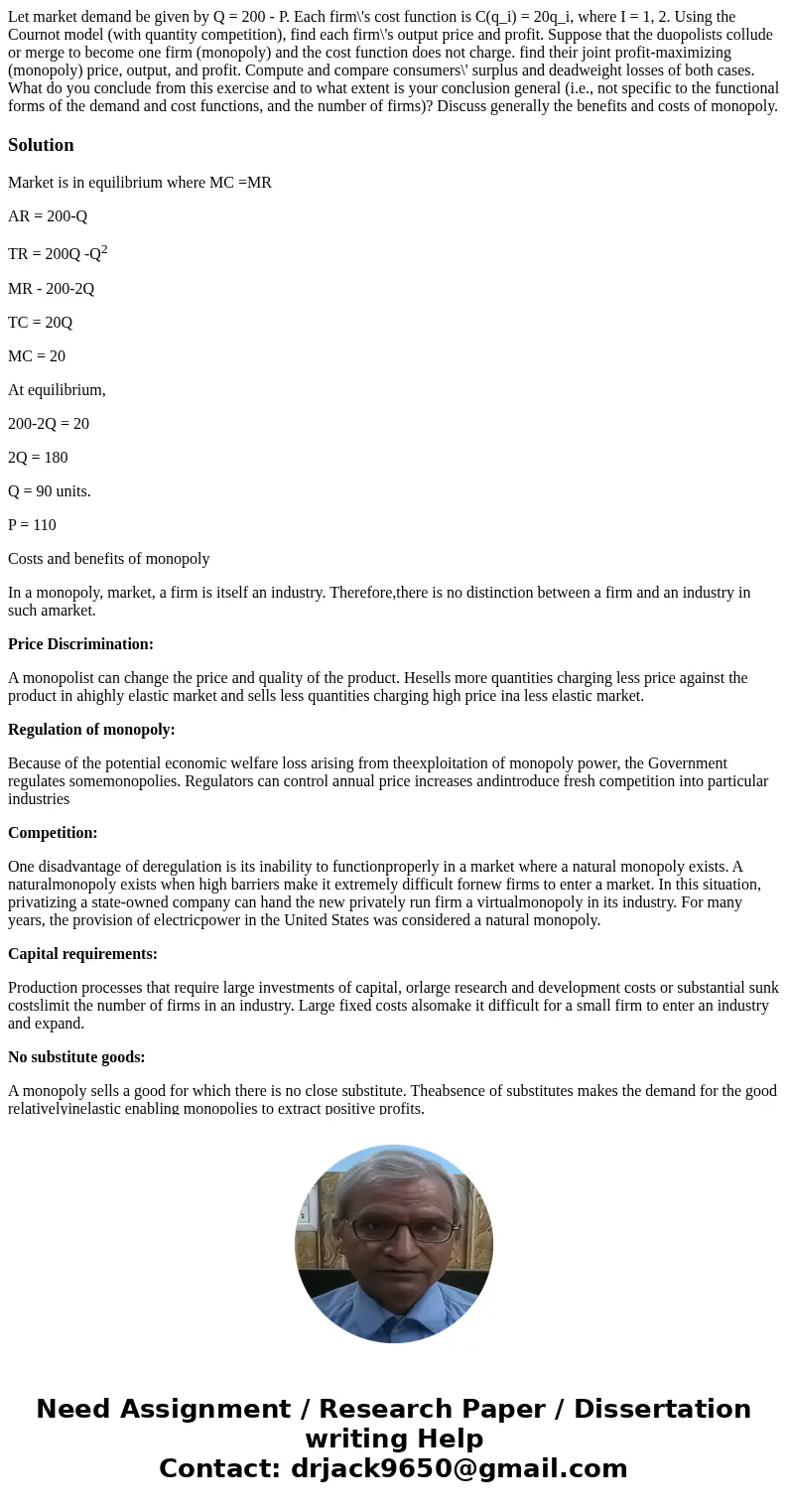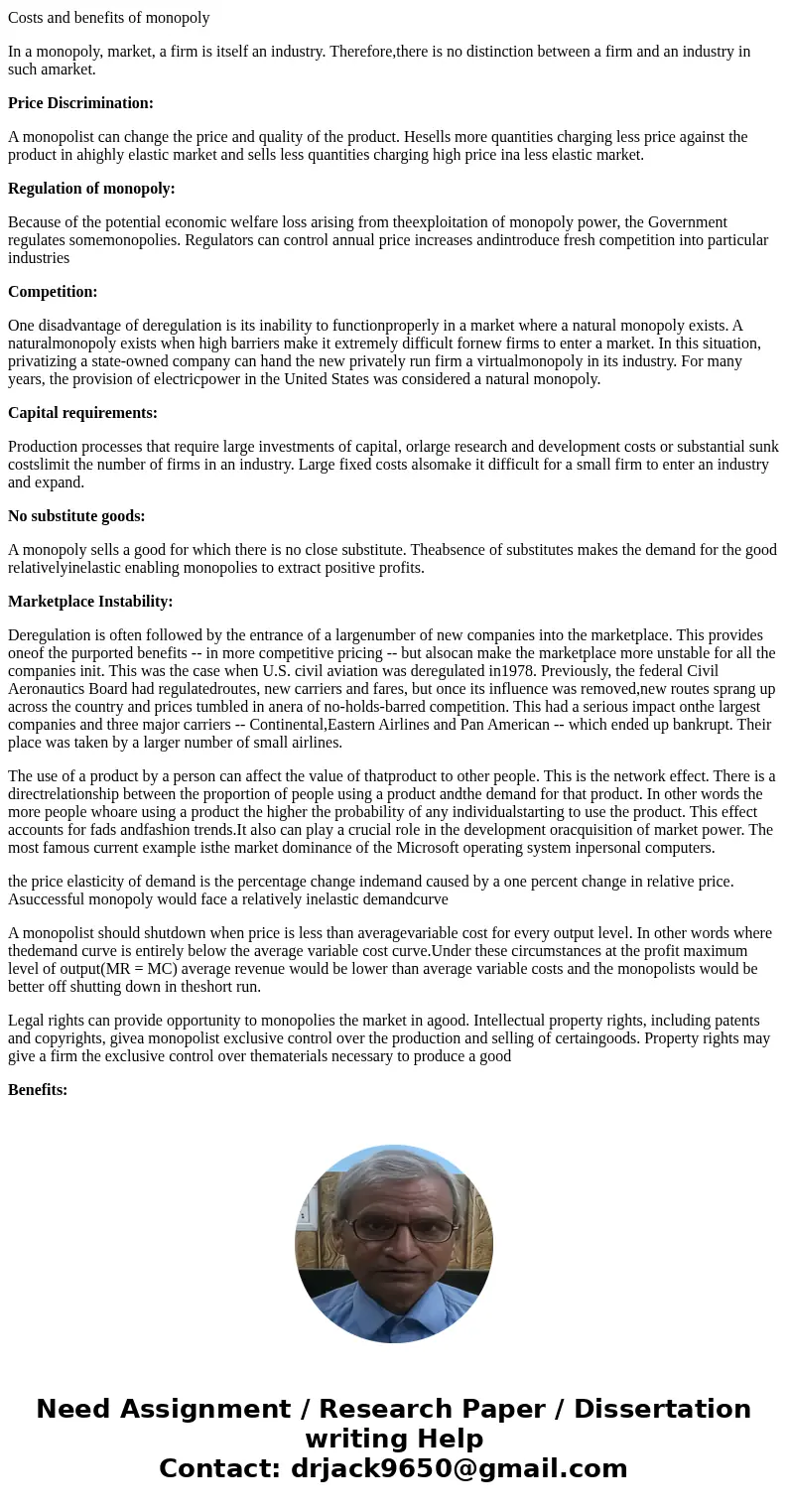Let market demand be given by Q 200 P Each firms cost func
Solution
Market is in equilibrium where MC =MR
AR = 200-Q
TR = 200Q -Q2
MR - 200-2Q
TC = 20Q
MC = 20
At equilibrium,
200-2Q = 20
2Q = 180
Q = 90 units.
P = 110
Costs and benefits of monopoly
In a monopoly, market, a firm is itself an industry. Therefore,there is no distinction between a firm and an industry in such amarket.
Price Discrimination:
A monopolist can change the price and quality of the product. Hesells more quantities charging less price against the product in ahighly elastic market and sells less quantities charging high price ina less elastic market.
Regulation of monopoly:
Because of the potential economic welfare loss arising from theexploitation of monopoly power, the Government regulates somemonopolies. Regulators can control annual price increases andintroduce fresh competition into particular industries
Competition:
One disadvantage of deregulation is its inability to functionproperly in a market where a natural monopoly exists. A naturalmonopoly exists when high barriers make it extremely difficult fornew firms to enter a market. In this situation, privatizing a state-owned company can hand the new privately run firm a virtualmonopoly in its industry. For many years, the provision of electricpower in the United States was considered a natural monopoly.
Capital requirements:
Production processes that require large investments of capital, orlarge research and development costs or substantial sunk costslimit the number of firms in an industry. Large fixed costs alsomake it difficult for a small firm to enter an industry and expand.
No substitute goods:
A monopoly sells a good for which there is no close substitute. Theabsence of substitutes makes the demand for the good relativelyinelastic enabling monopolies to extract positive profits.
Marketplace Instability:
Deregulation is often followed by the entrance of a largenumber of new companies into the marketplace. This provides oneof the purported benefits -- in more competitive pricing -- but alsocan make the marketplace more unstable for all the companies init. This was the case when U.S. civil aviation was deregulated in1978. Previously, the federal Civil Aeronautics Board had regulatedroutes, new carriers and fares, but once its influence was removed,new routes sprang up across the country and prices tumbled in anera of no-holds-barred competition. This had a serious impact onthe largest companies and three major carriers -- Continental,Eastern Airlines and Pan American -- which ended up bankrupt. Their place was taken by a larger number of small airlines.
The use of a product by a person can affect the value of thatproduct to other people. This is the network effect. There is a directrelationship between the proportion of people using a product andthe demand for that product. In other words the more people whoare using a product the higher the probability of any individualstarting to use the product. This effect accounts for fads andfashion trends.It also can play a crucial role in the development oracquisition of market power. The most famous current example isthe market dominance of the Microsoft operating system inpersonal computers.
the price elasticity of demand is the percentage change indemand caused by a one percent change in relative price. Asuccessful monopoly would face a relatively inelastic demandcurve
A monopolist should shutdown when price is less than averagevariable cost for every output level. In other words where thedemand curve is entirely below the average variable cost curve.Under these circumstances at the profit maximum level of output(MR = MC) average revenue would be lower than average variable costs and the monopolists would be better off shutting down in theshort run.
Legal rights can provide opportunity to monopolies the market in agood. Intellectual property rights, including patents and copyrights, givea monopolist exclusive control over the production and selling of certaingoods. Property rights may give a firm the exclusive control over thematerials necessary to produce a good
Benefits:


 Homework Sourse
Homework Sourse